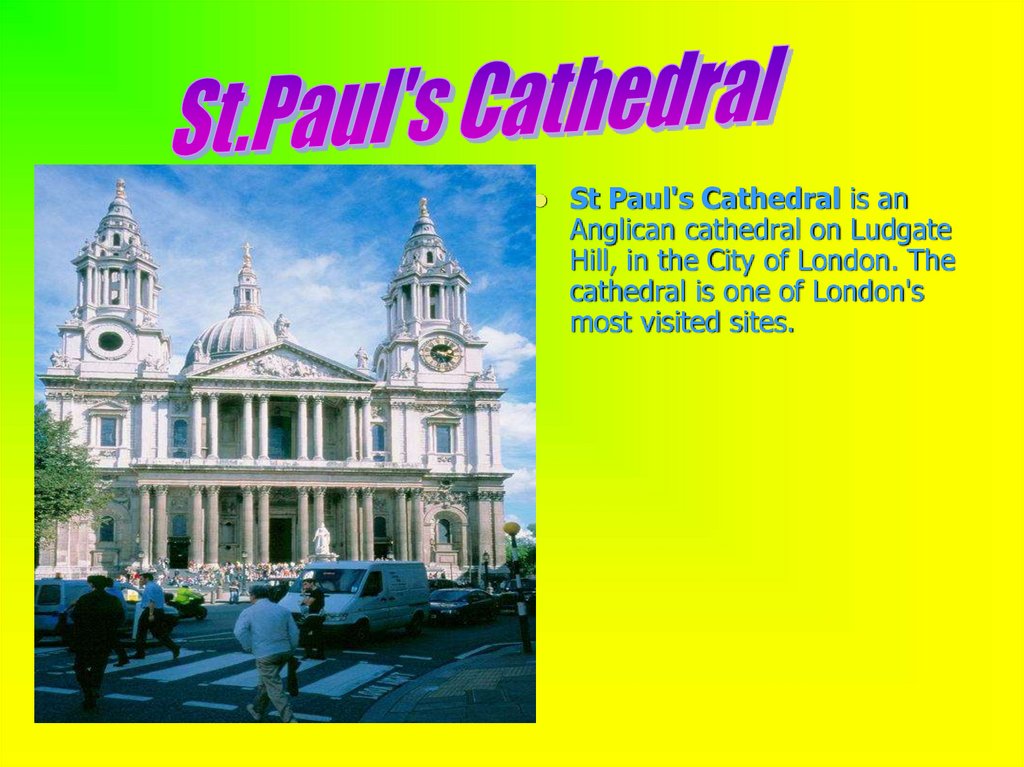Similar presentations:
Welcome to Great Britain
1. Английский язык.
Учитель Алфёрова Е. И.2. Презентация Great Britain
3. Welcome to Great Britain! Добро пожаловать в Великобританию!
Content.The Map of Great
Britain.
Symbols.
The head of state.
4. The Map of Great Britain. Of the four parts which make up Great Britain England is the largest,the industrial and most densely
populated part of the UnitedKingdom
5. Symbols of Great Britain.
The Coat of ArmThe rose was adopted as
England's emblem around the
time of the War of the roses - civil
wars (1455 - 1485) between the
royal house of Lancaster (whose
emblem was a red rose) King
Richard II and the Yorkists
6. The F lag
The cross of St. George, the Patron Saint of England, is thenational English flag.
The flag of the UK is officially called the Union flag, because it
embodies the emblems of three countries united under one
monarch.
The Union Flag is commonly known as the Union Jack, although
the exact origin of the name is unclear.
7. The head of state.
Queen ElizabethBorn April 21, 1926,
London. Elizabeth
Alexandra Mary Windsor
(British).
Elizabeth became Queen of
England on June 2, 1953
after being crowned at
Westminster Abbey in
London. She has three
sons, Prince Charles,
Prince Andrew and Price
Edward and one
daughter, Princess Anne.
8. London.
London isthe
capital of
England
and the
United
Kingdom.
London is
situated
upon
bank of
the River
Thames.
London.
9. Sightseeing.
There are manyplaces of interest
in London:
Big Ben,
Westminster
Abbey,
Buckingham
Palace, Parks,
Trafalgar Square.
10. Big Ben
It is popularly knownas Big Ben, but this
name is actually a
nickname for the
clock's main bell. The
tower was actually
built in the 12th
century when king
Нenry the eight
ordered his servants
to, because he didnt
have a watch.
11. Buckingham Palace.
It is theresidence of
the Queen
12.
Hyde Park is one of the largest parks in central London and one of the RoyalParks of London, famous for its Speakers' Corner.
13.
St James's Park isbounded by The Mall to
the north, Horse Guards
to the east, and Birdcage
Walk to the south. The
park has a small lake, St
James's Park Lake, with
two islands, Duck Island
(named for the lake's
collection of waterfowl),
and West Island
14.
Trafalgar Square isa square in London,
that commemorates
the Battle of
Trafalgar (1805), a
British naval victory
of the Napoleonic
Wars. The original
name was to have
been "King William
the Fourth's Square",
but George Ledwell
Taylor suggested the
name "Trafalgar
Square".
15.
Westminster Abbey is oneof the most famous, historic
and widely visited churches
not only in Britain but in the
whole Christian world
Westminster Abbey has had
bells since 1220 and bells in
use today include one 13th
century and two 16th century
bells. The Westminster Abbey
Company of Ringers provides
ringing at the Abbey for major
church festivals, Royal and
civic events.
16. Brighton.
Brighton is oneof the most
popular seaside
resorts in
Britain. It is
called
“London-by-the
sea”
17. The Thames
is a river insouthern England. It rises in
Gloucestershire and flows
through Oxfordshire,
Berkshire, Buckinghamshire,
Surrey, London, Essex, and
Kent.
The Thames
18.
The National Gallery is amuseum situated in London
located on the north side of
Trafalgar Square. It houses
Western European paintings
from 1250 to 1900 from the
national art collection of Great
Britain.[a] The collection of
2,300 paintings belongs to the
British public, and entry to the
main collection is free,
although there are charges for
entry to special exhibitions.
19.
St Paul's Cathedral is anAnglican cathedral on Ludgate
Hill, in the City of London. The
cathedral is one of London's
most visited sites.
20. The Tower of London
The Tower's primary function was afortress, a royal palace, and a prison
(particularly for high status and royal
prisoners, such as the Princes in the
Tower and the future Queen
Elizabeth I)





















 english
english geography
geography








